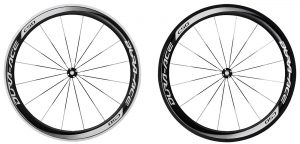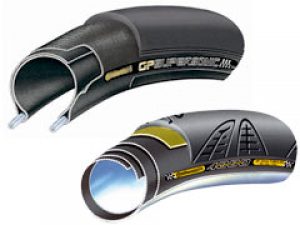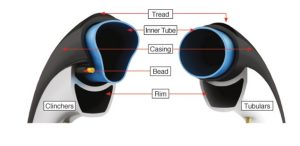Von Collins is an accomplished triathlete and endurance cyclist, and the author of four fitness and training books: Smarter Running, Your First Triathlon Guide, Fit Foods, and 30 Rut-Busting Workouts. He has been cited as a triathlon, cycling, and fitness expert by Healthline, CNET, Forbes, Eat This, Not That and other major outlets.
Clincher or Tubular? When it comes to bike tires, those are two of the longtime choices, with tubeless tires now becoming a major force as well. Which tire type to use is a common question among cyclists, triathletes, and recreational bikers. Why are there even different types of bike tires? Each evolved with its own set of reasons and following. We wanted to give you the definitive low-down on which tire you should go with.
Before we go any further, the clincher is the “normal” tire that you are probably used to from riding other bikes – ranging from your childhood bike to a BMX racer to a typical mountain bike or comfort bike. The clincher is far more common, and generally viewed as the standard. The newer tubeless is exactly what it sounds like – a tire that doesn’t need a tube, rather relying on tape on the rim and a liquid sealant to keep the air sealed in.
Tire Type | Pros | Cons | Common Use | Recommended |
Clincher | Historically the most common. Many are adept at working on them. | Need tubes to repair. "Pinch flats" are common. | Road, mountain, gravel, kids, commuter bikes. | |
Tubeless | Fewer flats, can run at low pressure. Easy road fix if not a bad flat. | Requires modified rim setup. | Mountain, gravel bikes. | |
Tubular | Lightweight | Uncommon, harder to work on. Tend to be expensive. | Road racing bikes. |
Clincher Bike Tires
Clinchers are the bike tires you rode as a kid. They have an outer “carcass” made for whatever type bike they need to be. The name clincher comes from the fact that these tires “clinch” to the rim of the wheel with a bead of hard rubber. Like a car tire, a clincher has an open bottom, and the only way it stays on the rim is to clinch to it.

A clincher needs an innertube in order to operate. The tube is what holds the air, and creates solid pressure against the tire. When you pump air into a clincher tire, you are really pumping air into the tube. The tire just sits on top of the tube.
You will have a couple choices in valve stems for pump air into the tire – Schrader vs. Presta valves. The one found on many kids and standard bike is a Shrader valve, it is wider and more basic. The thinner, sleeker valve stem is the Presta valve. It is what you find on pretty much all road or triathlon bikes, but you need to make sure you have a bike tire pump that can accommodate it.
Clinchers are easy. Easy to install, relatively easy to fix on the road if you get a flat.
There are many great clincher tires to choose from, and it really all depends on the combination of durability and performance you are looking for. Our favorite clincher tire right now is the Vittoria Rubino Pro. (find it here on Amazon).
Tubular Bike Tires
Hardcore cyclists and road bike racers have long considered tubulars to be the gold standard. They ride like a dream because of the lighter weight and tight adherence to the him.
Tubular tires look the same as clinchers on the outside, but work in a very different way. Tubulars are completely round, so there is no open part of the tire that needs to clinch. There is also no tube needed – -the tube is basically sewn into the tire and is part of it. As a result, the tubular is just one piece, whereas the clincher is two pieces (tube and tire). Tubular tires are often glued to the rim, because without some glue they tend to move around a bit.
Tubulars are less common, but have a strong following with many road and triathlon cyclists. We will get into a comparison below, but they tend to be lighter and sometimes more durable. If you are not used to working with tubulars, though, it may take a little practice to become handy with them.
Tubulars are a pain for install and repair, so bear that in mind.
Our favorite all-purpose tubular is the Vittoria Rubino G+ (here on Amazon).
What About Tubeless Tires?

A trend in recent years has been the rise of tubeless bike tires. They are just like they sound — road bike tires with no tubes at all, but unlike tubulars, they “clinch” to the wheel and do not need 360 degrees of surface area. Many believe that tubeless tires are the future of cycling. They are lighter, lower maintenance, and generally get fewer flats because you don’t have to worry about the delicate tube getting a tear or pinch, and because they typically have a sealant inside that will take care of minor potential leaks.
More and more new bikes are coming out with rims capable of using tubeless tires, and with tubeless tires as the default. Most of these rims are also suitable for clincher tires as well, however. Keep your eye on tubeless tires, though, as we think this is where more and more of the manufacturers’ R&D money will be going in the future. We would not be surprised if in a few years, we are all mainly riding on tubeless tires.
Some have complained that tubeless tires feel a little “dead” when riding, probably due to the fact that some tubeless rims ran a little heavy in weight, and that the sealant is sometimes overused during the install process. However, this can all be alleviated by investing in higher-end rims that offset any weight and feel difference.
My personal take on tubeless tires is that they make a ton of sense. They are less prone to pinch flats, can run at a lower PSI, and can still be used with a tube in the case of a severe flat. I really like them for gravel bikes, and am using them more for my road riding too.
A tubeless tire I recommend for road biking is the tubeless Rubino Pro, here on Amazon.

Comparison of Clincher vs. Tubular vs. Tubeless Bike Tires
Here are a few of the pros and cons of tubulars vs. clinchers, based on our experience in input from many experienced cyclists.
Cost. Advantage Clinchers. Clinchers tend to cost less than tubulars, and while not significant difference it is probably in the 20-30% range. What really causes the clinchers to cost less is the fact that when a tubular goes flat, you change the whole tubular. When a clincher goes flat, you typically just change the tube, which costs $5 – $7. (note that you need to change a clincher tire once in a while too)
Tubeless tires tend to be spendy, and the same for tubulars.
Note that tubulars require a different rim for your bike wheel, as well.

Simplicity. Advantage Clinchers. Some would argue that as long as you learn how to work on a tubular or tubeless, it is every bit as easy to change as a clincher. That is the problem though – most beginner and intermediate cyclists have not worked on tubulars, but they know clinchers because of the bikes they might have used when they were younger. Tubular tires require glueing them to the rim, and tubeless requires sealant and plenty of air to set the bead. That can be a tedious job, but something you get good at just like changing a clincher tire (for a road fix, you can usually get by without the glue for the ride home). Just know that if you make the move to clinchers, you will need to spend a little time learning how to change the tire.
Durability. Advantage Tubulars. This obviously depends on which tire you buy. A clincher Gatorskin is going to be stronger than a tubular slick. But all things being equal, the tubular is typically going to give you a little more mileage because of its construction. Having the tube basically sewn to the tire gives you a bit more strength, and it also eliminates the possibility of pinch flats or getting a small piece of rock in between the tire and tube (which almost always causes a flat).
Weight. Advantage Tubulars. Because you don’t have the clincher bead, and the tube is really part of the tire, the tubular tire is usually going to be a bit lighter. It is not uncommon for a tubular setup to be 200 grams lighter – per tire – than a clincher setup. While this might matter for elite cyclists, most of us would probably notice more of a weight difference if we simply lost a pound or two!

Road fixes. Advantage Clinchers and Tubeless. This one is a very clear advantage over the tubular. Fixing a road flat is pretty quick with a clincher, especially if you have a few reps under your belt. And fixing a tubeless should work pretty well, as long as it is not a bad rip in the tire.
Fixing a tubular, though, can take some time and is something you need to be patient with. While everyone is different, we would say that changing a clincher is half as much time as changing a tubular, and in some cases a tubular is going to be really hard to even do on the road. Just as importantly, keep in mind that when you are riding with a spare tubular, you have an entire tire in your pouch or jersey. When you are riding with a spare clincher tube, you only have a tube which takes up much less space.

Right: For a tubeless road fix, you need valve core remover, sealant, and air.
Safety. Advantage tubulars. Perhaps the best feature of a tubular tire is that it can be safely ridden at very low pressures, meaning that if you are getting a flat, you can still maneuver to a safe stop. When a clincher goes flat, it often goes flat in a hurry. Same with a tubeless, which goes flat quickly plus creates a mess of sealant. There is a point where that flatness will cause major handling issues, which can be a hazard for the rider. A tubular generally will not cause the same handling issues as it is going flat.
Availability. Advantage Clinchers (slight). You will typically find clinchers available with every possible bike tire model. For mountain biking and other bikes, you will see more and more tubeless but clinchers are still very common. Bike trainer tires, if you use them, will be more available in clinchers. Tubular tires are not nearly as common.
Which is Better: Clincher or Tubular (or Tubeless)?
For probably 80% of the cyclists out there, and especially for newer riders, we would recommend you ride on clinchers or tubeless, but more on that next. Clinchers are easier to use, to change, cheaper, and we prefer to have a stock of tubes on hand. Tubeless tires have the advantage of not having your tube ever get punctured, but rather using sealant to fix a puncture in the tire. The fact is that many tubeless riders also ride with a tube in their bike bag in case they have a really bad flat (you can always use a tube inside a tubeless tire as a last resort.)
As for tubular, they are probably not a good fit for most newer riders. You have to keep a stock of actual spare tubular tires, and they are more involved to fix.
We also think that it makes sense to become really good at changing one kind of tire, rather than “kind of” good at changing two to three types. Until about five years ago, that kind of tire for most was the clincher, but it is gradually shifting over to tubeless, especially in the gravel bike world.
Clinchers are more universal for the time being, so if you happen to get a flat on the side of a trail in the middle of nowhere, there is a much better chance that the passing cyclist will be able to help you with your clincher than a tubular… although increasingly you will find lots of riders carrying tubeless sealant.
With that said, your rims will ultimately decide which tires to ride in the short term. Rims are setup for one type of tire, and it requires a conversion to ride a different type of tire.

What If I’m Not a Road Biker?
This article is obviously geared to folks who ride a road or triathlon bike. If you are more of a gravel bike, we did an extensive gravel bike guide where we talk about the right tires. And of course, mountain and fat bikes are a whole different animal altogether. But we have you covered, we put together a guide to fat bike tires given the interest you all tend to show in that growing category of bikes.
Tubular tires tend to be more of a road bike or time trial bike thing, but even when they are on these types of bikes we most often see them on race bikes. Why? Because they are a pain to fix when you get a flat on a long ride, and the small weight advantage of a tubular is not noticeable to the average Joe.
Mountain bikers have the option of riding tubulars as well, but we don’t see it that option. With the growing dominance of tubeless tires, we expect them to become the norm for both mountain and gravel bikes.
Do Clincher Bike Tires Need Tubes?
The advent of tubeless bike tires has created some confusion – do clinchers really need tubes, if you can just slap a tubeless tire on a rim? Yes. Clincher-specific tires and rims are designed to operate only with tubes. In order to go tubeless, you either need to convert the rim to tubeless, which requires a bunch of rim tape, new stems, and a lot of elbow grease, or you need to invest in tubeless-ready rims.
On that note, the rims for tubeless, clincher, and tubular tires are all different, so step 1 is knowing which exactly you are dealing with!
What Are “Tubeless-Ready” Rims?
A tubeless-ready label is put on many new bike rims these days. What that means is that the rim already has the rim tape on it which is designed to become part of the sealing system for a tubeless bike tire. It means that you could put a tubeless tire on that rim, if you have the sealant that needs to go along with the installation. But you can also ride a tubeless-ready rim clincher-style, just putting a tube and tire on it. A little confusing, I know.
In short, you can use a tubeless or clincher on a tubeless-ready rim, but you can only use a clincher on a non-tubeless-ready rim (assuming we are not talking about tubulars here.)
Other Reading
If you are learning more about triathlons and cycling, we have a few other pieces for you. Be sure to check out our popular piece on the best entry-level triathlon bikes, which discusses our favorite bikes for newer triathletes. Then, look at our piece on the 3 Best Road and Tri Bike tires, which discusses the tires we like best for a combination of performance and durability.








Great article. And I too like the Rubino pro clincher tyres. Inexpensive, weight and rolling resistance equal to much more expensive tyres, and durable.
Great article. And I too like the Rubino pro clincher tyres. Inexpensive, weight and rolling resistance equal to much more expensive tyres, and durable.
Great piece. I bought a second hand triathlon bike and didn’t even know tubular tyres existed until I went to change a flat tyre and noticed the glue. Looking forward to learning more about them
Thanks for this useful article. Among clincher vs tubular vs tubeless tires, I thinking about what tire option to pick out.
Correct me if I’m wrong, but it was generally accepted that tubular tires had lower rolling resistance than clinchers. But is that still the case?
Yes, we have read that too, but we also think the difference is so miniscule you would not notice it unless you are doing time trails in a velodrome. With more and more riders going to gravel bikes and other options, rolling resistance takes on a bunch of different dimensions.